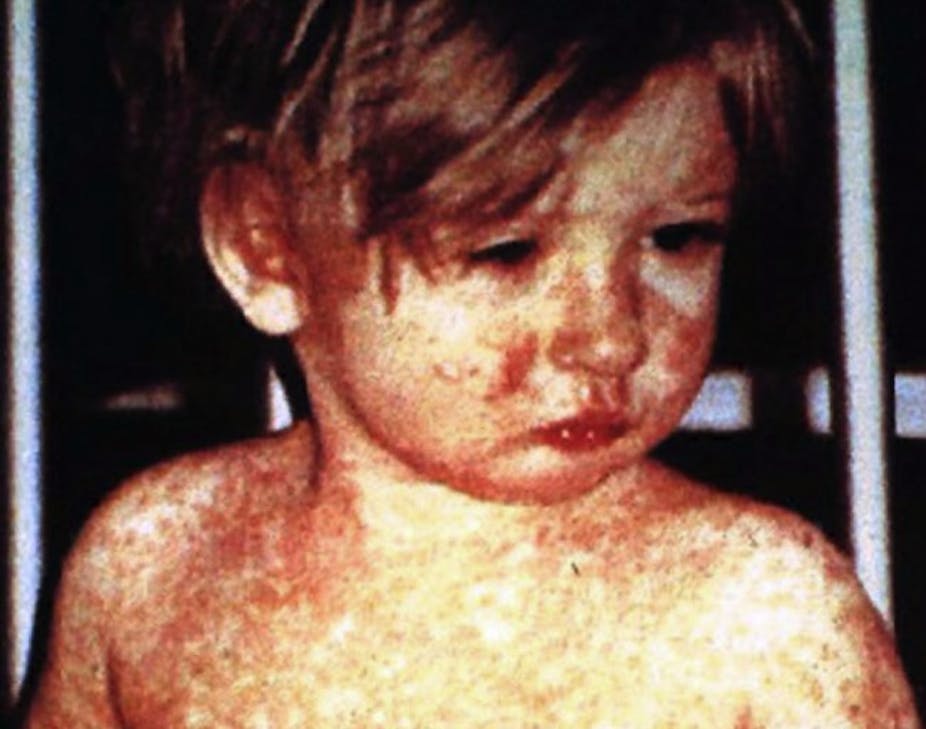New South Wales has become the latest Australian state to issue an alert about a measles outbreak, joining Victoria and Queensland.
Queensland’s chief health officer has even written directly to parents to encourage them to make sure their children’s vaccinations are up-to-date.
The move is in response to an ongoing outbreak of measles in the state, with 21 cases so far this year. There have also been 24 cases reported in New South Wales and 25 in Victoria in the same time.
Despite the availability of a safe, effective vaccine, measles outbreaks continue to occur throughout the world and the country - even though local transmission in Australia has been largely eliminated.
The virus
Measles is one of the most transmissible, infectious diseases. The likelihood of an unimmunised person who comes in contact with an infectious case of measles being infected is around 90%.
This rate of infection requires very high levels of vaccination to maintain herd immunity. Herd immunity is conferred when the majority of people have been vaccinated so the disease is stopped from spreading across the community.
Measles is very infectious because it’s transmitted by tiny droplets that can remain in the air for a prolonged period, even after the ill person has left the room.
Places where ill people congregate, such as the waiting rooms of hospital emergency departments or medical clinics, are prime spots for the disease to spread. Indeed, “waiting room measles” has been described in Australia and overseas.
This is the reason health authorities recommend you call your doctor or the hospital before going to see them if you are unwell with measles symptoms.
People also shed the virus for several days before the appearance of the typical rash, increasing the risk of silent transmission.
The vaccine
Of course, no vaccine (or any other medical intervention) is perfect, but as far as vaccines go, the one for measles-mumps-rubella is pretty good.
Around 95% of people who receive a single dose of MMR will develop immunity to measles and most who don’t will do so with the second dose. Sometimes immunity wanes, but, overall, fewer than one in 20 people who have been vaccinated will remain susceptible to the disease.
In Australia, vaccination is recommended for anyone born after 1966, who has definitely not received two doses of a measles vaccine. People born before that year are highly likely to have had measles and have natural immunity.
As part of the state’s outbreak response, the vaccine is currently being supplied for free in Queensland (although doctors may still charge fees for administering it).
People who aren’t sure whether they have been vaccinated should err on the side of caution and get a booster; the side-effects are minor, and there’s no harm in having an additional dose.
Safety profile
The measles vaccine is safe.
Fever is relatively common side effect, particularly after the first dose. And, on rare occasions, the vaccine can cause a rash similar to measles, but it’s mild and transient.
Extremely rare cases of inflammation of the brain have also been reported. But the measles virus itself causes encephalitis (swelling of the brain) in one in 1,000 cases. One in ten of these people will die and many others will be disabled because of brain damage.
Around one in 100,000 children who recover from measles will go on to develop a degenerative brain disease that is almost invariably fatal.
Concerns over safety of the MMR are almost entirely based on a 1998 paper by Andrew Wakefield. The paper was eventually retracted and Wakefield was struck off the medical register for research fraud and unethical treatment of the children he researched.
But the damage was done and panicked parents refused to have their children vaccinated. These children are now as old as 15, and one of the key age groups for transmitting infections.
Anti-vaccination lobby groups continue to quote the Wakefield paper, despite the fact that he has been discredited and the paper being retracted,
Source of cases
Outbreaks of measles in Australia always begin with imported cases, that is, from someone getting infected while travelling abroad. These people cause secondary cases when they come in contact with an unvaccinated local upon their return.
The WA Department of Health recently issued a warning to travellers to Bali for this very reason. There isn’t anything special about Bali and measles, it’s just a common destination for Australian travellers and so a frequent source of infections.
Travellers to Bali, or any other overseas destination should include the MMR shot in their pre-travel vaccinations.
Measles is a very efficient infection; it was the fifth-leading cause of childhood death worldwide in 2000 (estimated at more than 750,000 deaths).
But vaccination has made the disease so rare in Australia that many young (and some not-so-young) doctors have never seen a case. If the current outbreaks continue, we may see the first Australian measles death in years, which would be a completely preventable tragedy.

